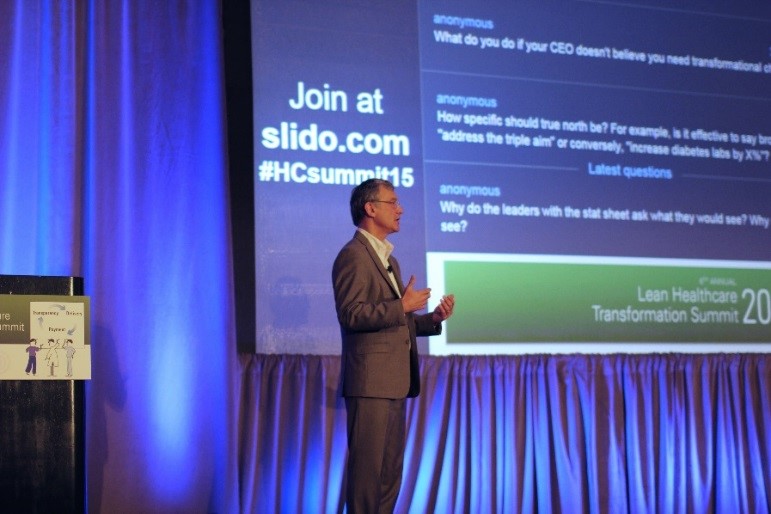Summit Reflections: Powerful Data and Mindful Metrics
Posted on by CATALYSIS
 “None of us are reliable, yet.”
These were the opening remarks of the Center’s John Toussaint, MD at the 6th Annual Lean Healthcare Transformation Summit held in Dallas, TX last month. His statement was both a challenge and an encouragement to over 650 people gathered to share, learn, and connect. There was celebration of the good work that has been done and excitement about the new ideas to transform and improve. The energy was contagious.
One of the prevalent themes shared at this year’s Summit was passion to tackle healthcare’s future challenges. Toussaint acknowledged there is a long way to go, but the Summit addressed possibilities in how to achieve excellence. Part of the issue is addressing the current state. In the closing keynote, Jim Womack, founder of the Lean Enterprise Institute, noted: “It’s easier to buy a quality car than it is to find a quality doctor.” In this light, a common concern addressed throughout the Summit was the lack in data transparency surrounding healthcare.
Beth Daley Ullem provided us with a clear picture of this through personal narrative during her keynote. After losing her first son to medical error, her second son was diagnosed with Tetralogy of Fallot (a rare congenital heart defect) while she was pregnant. She searched for data that would allow her to decide where to have her son treated. But the data she needed wasn’t available. Certainly, with the Internet, there was data available, Daley Ullem explained, but this data can “also [be] really dangerous because there’s almost too much and we’re not helping [patients] sort that information.” We live in the Information Age, but in relating to healthcare how do we know how much of it is trustworthy? How much of it is regulated? How much is presented in a way that helps patients compare and make the best decision for their treatment?
We also can’t ignore what Michael Erikson of Palo Alto Medical Foundation (PAMF) shared during his keynote—“Out of pocket costs are now the leading factor of how a patient or consumer determines where they’re going to get healthcare.” Most patients can’t ignore the cost factor, and the current state of data transparency makes it challenging to determine the best option. There have been attempts by organizations, like OkCopay, to compile and organize data for patients to decide where to go for their healthcare needs with a focus on cost comparison. Even recently, a non-profit news organization has worked to compile statistical information on surgeons comparing them against one another using a scorecard system. At the Summit, we heard from Doug McKeever of CalPERS, the country’s second largest employer health benefits purchaser, about how they have used data they’ve collected on cost and outcomes to determine what prices they are willing to pay for procedures. These groups are tackling the issue of data transparency because of the growing demand for it in healthcare.
The demand is for reliable, comparable, and accessible data for payers, so they can make a “good purchase decision” (a phrase Beth Daley Ullem referenced during her presentation).
This demand is not going away. Customers can easily access information to make purchase decisions in other industries (like Amazon and Uber). Furthermore, other industries are pushing data out to customers in accessible ways, like for example regular status updates via text or email. This customer-centric focus is beginning to shift in healthcare. As Michael Erikson explained, PAMF has started work to meet this need for getting data and care to the patient on their terms, for example MDLive, a service which allows patients to interact with doctors via remote access. At PAMF, they are changing their processes in response to the need to be “patient-centered” in their care.
Additionally, another significant change coming in healthcare is in payment structures. There is a substantial push from purchasers like CalPERS and also from the government (with legislation like the Cadillac Tax) to reduce cost. What does this mean? That the fee-for-service structure is going to be replaced by some sort of value-based purchasing system. Doug McKeever explained during the Summit that CalPERS is using “reference-based pricing” to determine the threshold for what they will pay for certain procedures. The challenge with this, as Jim Womack explained, is that if the healthcare community doesn’t get involved in the conversation, it will end up with a long list of “mindless metrics” to measure and report. Metrics, he said, that “seemed to somebody like a good idea without any knowledge of how you actually create value for the patient.” And when healthcare providers aren’t able to meet these metrics, they will game (fudge their numbers, etc.), then more audits and mindless metrics will come, without any true improvement in patient care and delivery.
The challenges listed above seem daunting, certainly, but throughout the Summit speakers and presenters shared ways to meet these challenges:
“None of us are reliable, yet.”
These were the opening remarks of the Center’s John Toussaint, MD at the 6th Annual Lean Healthcare Transformation Summit held in Dallas, TX last month. His statement was both a challenge and an encouragement to over 650 people gathered to share, learn, and connect. There was celebration of the good work that has been done and excitement about the new ideas to transform and improve. The energy was contagious.
One of the prevalent themes shared at this year’s Summit was passion to tackle healthcare’s future challenges. Toussaint acknowledged there is a long way to go, but the Summit addressed possibilities in how to achieve excellence. Part of the issue is addressing the current state. In the closing keynote, Jim Womack, founder of the Lean Enterprise Institute, noted: “It’s easier to buy a quality car than it is to find a quality doctor.” In this light, a common concern addressed throughout the Summit was the lack in data transparency surrounding healthcare.
Beth Daley Ullem provided us with a clear picture of this through personal narrative during her keynote. After losing her first son to medical error, her second son was diagnosed with Tetralogy of Fallot (a rare congenital heart defect) while she was pregnant. She searched for data that would allow her to decide where to have her son treated. But the data she needed wasn’t available. Certainly, with the Internet, there was data available, Daley Ullem explained, but this data can “also [be] really dangerous because there’s almost too much and we’re not helping [patients] sort that information.” We live in the Information Age, but in relating to healthcare how do we know how much of it is trustworthy? How much of it is regulated? How much is presented in a way that helps patients compare and make the best decision for their treatment?
We also can’t ignore what Michael Erikson of Palo Alto Medical Foundation (PAMF) shared during his keynote—“Out of pocket costs are now the leading factor of how a patient or consumer determines where they’re going to get healthcare.” Most patients can’t ignore the cost factor, and the current state of data transparency makes it challenging to determine the best option. There have been attempts by organizations, like OkCopay, to compile and organize data for patients to decide where to go for their healthcare needs with a focus on cost comparison. Even recently, a non-profit news organization has worked to compile statistical information on surgeons comparing them against one another using a scorecard system. At the Summit, we heard from Doug McKeever of CalPERS, the country’s second largest employer health benefits purchaser, about how they have used data they’ve collected on cost and outcomes to determine what prices they are willing to pay for procedures. These groups are tackling the issue of data transparency because of the growing demand for it in healthcare.
The demand is for reliable, comparable, and accessible data for payers, so they can make a “good purchase decision” (a phrase Beth Daley Ullem referenced during her presentation).
This demand is not going away. Customers can easily access information to make purchase decisions in other industries (like Amazon and Uber). Furthermore, other industries are pushing data out to customers in accessible ways, like for example regular status updates via text or email. This customer-centric focus is beginning to shift in healthcare. As Michael Erikson explained, PAMF has started work to meet this need for getting data and care to the patient on their terms, for example MDLive, a service which allows patients to interact with doctors via remote access. At PAMF, they are changing their processes in response to the need to be “patient-centered” in their care.
Additionally, another significant change coming in healthcare is in payment structures. There is a substantial push from purchasers like CalPERS and also from the government (with legislation like the Cadillac Tax) to reduce cost. What does this mean? That the fee-for-service structure is going to be replaced by some sort of value-based purchasing system. Doug McKeever explained during the Summit that CalPERS is using “reference-based pricing” to determine the threshold for what they will pay for certain procedures. The challenge with this, as Jim Womack explained, is that if the healthcare community doesn’t get involved in the conversation, it will end up with a long list of “mindless metrics” to measure and report. Metrics, he said, that “seemed to somebody like a good idea without any knowledge of how you actually create value for the patient.” And when healthcare providers aren’t able to meet these metrics, they will game (fudge their numbers, etc.), then more audits and mindless metrics will come, without any true improvement in patient care and delivery.
The challenges listed above seem daunting, certainly, but throughout the Summit speakers and presenters shared ways to meet these challenges:
- Understand the information flow in your system, use real-time data to make better decisions and adjust
- Experiment, experiment, experiment
- Share and compare—with each other, with payers
- Dialogue with all the stakeholders
 If you are looking for future opportunities to connect with other lean thinkers, a second rendition of our Lean Leadership Series is coming up October 13-15, in Stuart, FL. Also, it’s never too early to start planning for the next Lean Healthcare Transformation Summit, which will be in Miami, FL, June 15-16, 2016. Save the date and mark your calendars!
If you are looking for future opportunities to connect with other lean thinkers, a second rendition of our Lean Leadership Series is coming up October 13-15, in Stuart, FL. Also, it’s never too early to start planning for the next Lean Healthcare Transformation Summit, which will be in Miami, FL, June 15-16, 2016. Save the date and mark your calendars!








Leave a Reply